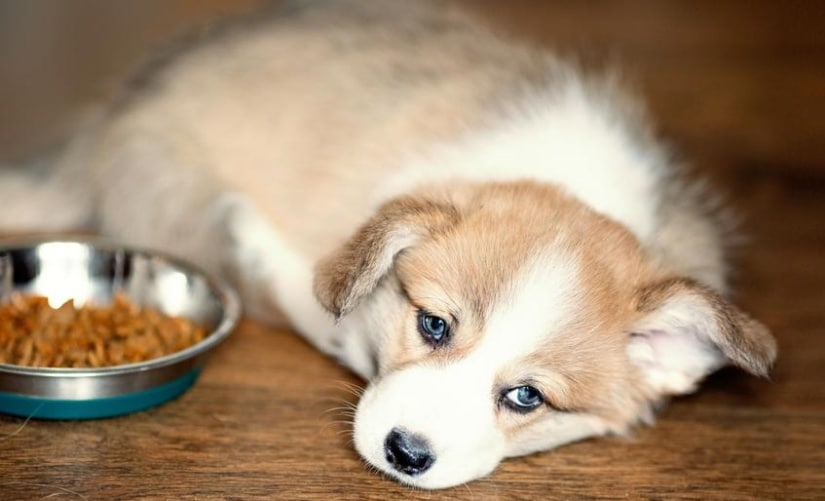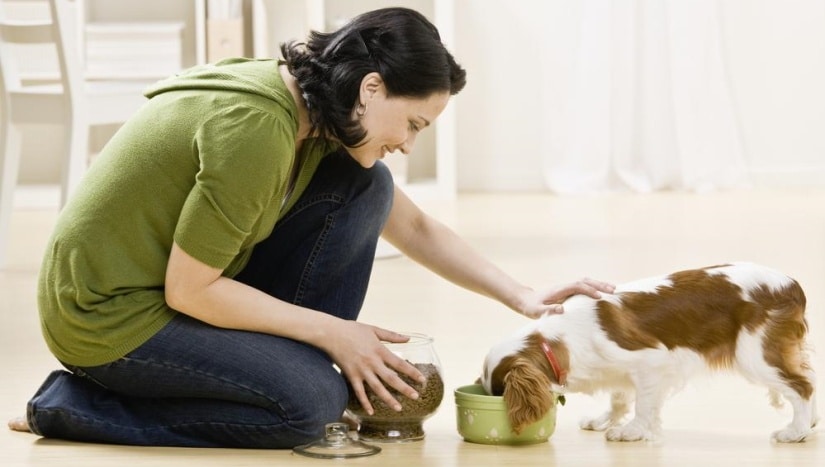If you’ve added a new puppy to your family, you know that they are fun, cute, and playful. But it’s not all fun and games with a new pup. You also need to make sure they’re well taken care of. Here are some feeding and diet tips for your new puppy so that they can grow into a healthy adult.
There are many rules to remember when feeding a new pup, especially if they have allergies or intolerances. And depending on your dog’s breed or size and activity level, they may need more attention and care during mealtime.
Here’s what you need to know about feeding your new puppy.
1. How to Feed Your Puppy
When feeding a new household member, you want to give them their food in a quiet and safe place.
First, this keeps them from being interrupted while eating since puppies can get easily distracted. Second, it keeps them and other puppies or kids safe from potential harm.
If you’re feeding more than one puppy, keep the pups apart to avoid fights. And if you have kids, teach them to leave the dogs alone while they eat so they aren’t bitten or scratched.
Next, make sure where you feed your new canine is clean and can be cleaned easily, especially if feeding your pup wet food. We suggest a feeding mat, vinyl flooring, tile, or even an open kennel.
2. What to Feed Your Puppy
What are the best foods to feed your puppy? While most commercial dog foods are safe for your dog to eat, your puppy needs targeted nutrition to help them grow into a healthy adult. Here is what you need to feed them.
Dog Food For Puppies
First, do not feed a puppy under one year old anything other than puppy food. Adult dog food and puppy kibble are created differently since puppies need more calories, protein, and fat to grow.
And, puppy food usually includes higher sources of certain nutrients, like DHA, to ensure that your pup grows mentally and physically well.
If you have a large breed, you may be able to switch them to adult food starting at around 10 months since large breeds typically have a shorter life span and reach adulthood faster. But before you make the switch, talk to your veterinarian.
High-Calorie
Next, choose a high-calorie diet. Puppies need around 30 to 35 calories per pound that they will weigh in adulthood.
For example, a puppy that will be 50 pounds when fully grown will need at least 1,500 calories daily. And, if your dog is active or working, they will need about 40 calories per pound.
High-Protein
Puppy food needs at least 22% Crude Protein to support your dog’s metabolism, lean muscle mass, and help support the healthy development of their organs.
More active puppies should be fed a diet with at least 25% Crude Protein to ensure muscle growth and repair.
Smaller Kibble Size
One of the most significant differences between adult dog food and puppy food is the kibble size. And until your pup is big enough to crunch through larger kibble, puppy food offers a safe and easier-to-eat option.
If you have a small breed, get the “small breed puppy” option for tinier kibble.
3. How Much to Feed Your Puppy

Most puppies love to eat, but they shouldn’t eat too fast or too much. This can cause tummy upset, vomiting, and bloat.
Instead, feed your pup smaller meals throughout the day. While adult dogs can get by on feedings once or twice daily, puppies need at least three meals daily.
Most puppy feeding guidelines recommend:
- Two months or younger old: 4 to 6 meals a day
- Two to three months old: 4 meals a day
- Four to six months old: 2 to 3 meals a day
- Six months and older: 2 meals a day, depending on breed and size
Of course, always talk to your vet before making any diet changes. They can tell you how often your pup’s specific breed needs to eat and why.
Dr. Rucker from Winchester Pet Care Center recommended, “Most puppies thrive on three meals a day after four months, so you only need to switch to twice a day once they reach adulthood.”
4. Food and Exercise for Puppies
If you have a highly active or working dog, you want to avoid feeding them immediately before or after any strenuous activity. Instead, try to allow 30 minutes to an hour to pass before giving them their meal.
If you have a hunting dog, talk to your vet about feeding them once daily since this is the standard diet for most hunting breeds. They may recommend a twice-a-day feeding while they’re a puppy and weaning them off the second meal over time.
5. When to Switch Your Pup’s Food
Most puppies need to stay on puppy food until they’re at least one year old.
However, smaller breeds don’t typically reach adulthood until 16-18 months. This includes breeds like Chihuahuas, Shih Tzu, and Pomeranians. So speak with your vet before switching them to adult food.
Larger breeds, like Rottweilers and Huskies, can usually switch to adult food around 10 months old, especially if they’re working dogs. But before making the switch, be sure to confirm their growth with your vet.
6. What Not to Feed a Puppy
While many foods are safe for puppies, some are not. First, many vets recommend that you don’t feed your pup a raw diet, to reduce the risk of food poisoning. Consult a pet nutritionist with credentials if you want to provide them raw food.
There are other unsafe foods too, including;
- Chocolate
- Garlic
- Onions
- Grapes or raisins
- Cooked bones
- Caffeine
- Sugar
- Xylitol (found in some peanut butter)
Consult your vet for a complete list of food to avoid, and only feed your puppy dog food or treats made for them.
7. Should You Feed Wet or Dry Dog Food?
It doesn’t matter if you feed your dog wet or dry food. You can even provide them a combination of both, especially if they’re a picky eater. Which option you choose depends on your dog and their nutritional needs.
Dry food is great for ease of use and stores for a long time. It’s also easier to feed multiple puppies at a time.
Wet food offers more moisture and may work well for fussy pups that can’t chew dry kibble. But, it’s also messier and more expensive, especially if your dog is a larger breed.
If you’ve just brought your pup home for the first time, keep them on the food recommended by the breeder or shelter. Then, you can adjust their diet by changing their food over time. To do this, mix a little of their new food into the old one, adding more over seven to 10 days until they’re eating the new food.
8. Feeding Multiple Puppies
When feeding multiple puppies, you’ll want to have a designated spot for each one to eat.
And we suggest feeding them all at the same time. To do this, you may need to measure the food first, then dish out the bowls when meal time is ready. This keeps the puppies from fighting or stealing food and ensures everyone eats to fit their caloric needs. A little bit of positive reinforcement dog training while they are in this phase is encouraged.
9. Feeding a Puppy with a Sensitive Stomach
If you have a puppy with allergies or a sensitive tummy, don’t fret. It’s easier than it seems to feed them a healthy diet.
First, rule out any allergies. While some vets can test for this, it’s harder to do when you have a puppy. So the easiest thing to do is switch to a bland or limited ingredient diet. And stay away from common allergens like chicken, beef, soy, and gluten.
Next up, add some canned pumpkin or cooked and mashed sweet potato to your pup’s food. These high-fiber vegetables help settle a sensitive tummy, offer prebiotics for gut health, and keep diarrhea and constipation at bay.
Please see your vet if your pup doesn’t feel good after making these switches. Disorders like IBS or gastroenteritis are common in dogs; your vet can diagnose them.
10. Storing Puppy Food
Luckily, storing puppy food is easy. Keep it in a cold and dry place for dry kibble, preferably in a sealed container.
Wet food should be refrigerated, wrapped, sealed, and fed quickly if the can is open. Once the can is open, it will only last up to 36 hours. Unopened cans can usually store for upwards of 18 months.
Feeding Your Puppy FAQs
If you have questions about feeding your puppy, you aren’t alone. Here are some frequently asked questions and their answers.
How much should I feed my puppy?
You should feed your puppy the calories that their size and breed require. You can calculate this number by multiplying 30 calories by their adult ideal weight. You can also speak with your vet about what they recommend for calories, protein, and fat.
How can I check if my puppy is gaining weight?
If your pup looks chubby, they’re most likely gaining weight. But, this may not always be bad since puppies tend to grow outward before they gain length and height. If you think your puppy is gaining too much weight, talk to your vet about it.
How can I check if my puppy is losing weight?
On the other hand, losing weight, especially sudden, is something that you should take your pup to the vet immediately. Sudden weight loss can suggest worms, parvo, or any other number of diseases.
Puppies shouldn’t lose weight, so they must rule out health issues. If your dog has no medical problems, your vet will most likely recommend feeding them more often or a higher calorie and fat food.
How should I serve wet puppy food?
It’s best to serve wet food at room temperature. It’s more appealing to dogs and makes it easier to eat.
How should I serve dry puppy food?
You should be able to scoop out dry food and serve it as is. But if you have a picky pup, try adding broth or water to make it moist and easier to eat. If you decide to add these, you’ll need to refrigerate the food if your pup doesn’t finish it.
What are the signs that I am feeding my dog the wrong diet?
Their bodies will usually inform you if your pup eats the wrong diet. Some common signs of allergies or intolerances include
- Excessive gas
- Upset stomach
- Weight loss
- Itchy, dry, inflamed skin
- Licking constantly
- Loose stool
- Constipation
- Whining or crying after eating
If your dog has any of these symptoms, please take them to your vet immediately.
Can I feed my puppy treats?
Yes! But be sure to give your pup treats only if they are four months or older. If they’re younger than that, they could choke.
Even if they are older than four months, only give puppies easy-to-eat treats — including soft treats. They can cause choking or block your dog’s airways if they’re too big. Many different treats are marketed to small and young dogs.
Also, don’t give them treats high in fat, salt, or sugar; only feed treats in moderation. This helps your pup avoid weight gain and potential health issues related to their diet.
The Best Feeding And Diet Tips For Your New Puppy
These rules can make feeding your puppy easy, safe, and healthy. Plus, they keep your new pup happy and can ensure that they grow into a muscular adult in good shape. These tips are easy to follow, so don’t forget to utilize them when feeding your new puppy!
